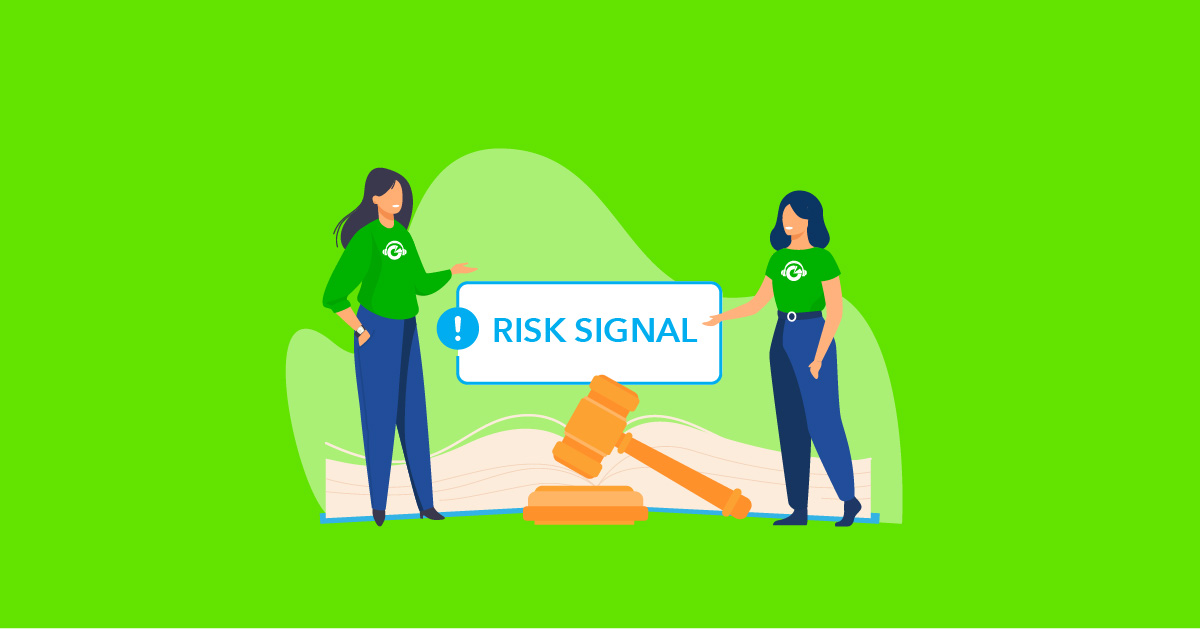Episode 31: [Sneak Peek] 2023 CFPB Consumer Complaint Trends & Insights

Episode Description
This week, I sat down with our Content Marketing Manager here at PerformLine, Gianna Barrere, to discuss our annual Complaint Risk Signal Report.
Listen as Gianna and I discuss:
- The background of the report, the importance of consumer complaints, and how they are used by the CFPB to regulate financial institutions
- Key topics and a few interesting takeaways the report covers this year
- Guidance on how organizations can establish a process for monitoring these complaints in the database system
- Best practices for how to implement monitoring of marketing communications for compliance with regulations effectively
- Finally, we share how you can access the report and give a rundown of the additional content pieces coming out this quarter that you can look forward to
Show Notes:
- [Exclusive First Access] CFPB Complaint Risk Signal Report: https://bit.ly/3rqMs7t
- CFPB Consumer Complaint Database Cheat Sheet: https://bit.ly/3rfU8JR
- Subscribe to our content: https://bit.ly/45Zkoqv
- Connect with Gianna Barrere: https://www.linkedin.com/in/gianna-barrere/
- Connect with Ashley “AC” Cianci: https://www.linkedin.com/in/ashley-cianci/
Subscribe to COMPLY: The Marketing Compliance Podcast
About COMPLY: The Marketing Compliance Podcast
The state of marketing compliance and regulation is evolving faster than ever, especially for those in the consumer finance space. On the COMPLY podcast, we sit down with the biggest names in marketing, compliance, regulations, and innovation as they share their playbooks to help you take your compliance practice to the next level.
Episode Transcript:
Ashley:
Hey there, COMPLY podcast listeners, and welcome to this week’s episode. This week I sat down with our content marketing manager here at PerformLine, Gianna Barrere, to discuss our annual Complaint Risk Signal Report. Listen to today’s podcast as Gianna and I discussed the background of this report, the importance of consumer complaints, and how they are used by the CFPB to regulate financial institutions key topics and a few interesting takeaways to report covers this year. Guidance on how organizations can establish a process to monitor these complaints and the database system. Some best practices for how to implement monitoring and marketing communications for compliance with regulations effectively. Finally, how you can access a report and a rundown of the additional content pieces coming out this quarter that you can look forward to. As always, thanks for listening, and enjoy.
Ashley:
Hey Gianna, welcome back to the Comply podcast.
Gianna:
Hey Ashley, thanks so much for having me again. Always a pleasure.
Ashley:
Awesome. We are so happy to have Gianna back. For those who missed you in previous podcasts, can you just start by telling us a little about yourself and your current role here at PerformLine?
Gianna:
Yeah, I am Gianna, Content Marketing Manager here at PerformLine, and my role is exactly what it sounds like I am responsible for overseeing all of PerformLine’s content, including strategy, planning, writing, you name it. I started at PerformLine as an intern back in 2017, and I have been here full-time since 2019. Being a content marketer is really something that I kind of grew into during my time here at PerformLine, and it really all started with the piece that we are going to be talking about today, the Complaint Risk Signal Report. So, I am really excited to be here talking about it today.
Ashley:
We are so lucky to have Gianna as our Content Marketing Manager. Like she said, everything you see content-wise across the web that PerformLine produces, Gianna has a hand in. We are lucky to have her.
Gianna:
Thank you.
Ashley:
Today, like she said, we are going to talk about our annual Consumer Complaint Risk Signal Report. Gianna, can you start by giving us some background on this report? How long have we been producing it, and why is it important?
Gianna:
Sure. This report was created before my time at PerformLine. I believe the first edition was published all the way back in 2015, and when I came back to PerformLine full-time, this report was really my first big content project that I was assigned. I have been writing this report every single year since 2019, and this year will be our eighth edition of the report. Even though I was not here when the first report was created, I cannot necessarily speak to how it came to fruition. I think the idea kind of was that the CFPB makes all of this consumer complaint information available to the public, but how can we take this data and turn it into easy-to-digest and actionable insights, particularly around marketing compliance? How does this complaint data coincide with what the CFPB has been working on, and what are kind of the risk signals that come from it? That is the way I look at it every single year when I write it.
Ashley:
It is so handy to take the immense amount of data that goes into the database. We are basically giving it to you in a fantastic, incredibly visual report that you guys will see when it is finally published. So incredibly handy. Gianna, can you just provide some background on the importance of consumer complaints in general and how they are used by the CFPB to regulate financial institutions?
Gianna:
Yes, of course. But, before I jump into kind of the importance of consumer complaints, I just want to note that I am not a marketing compliance expert. I have never worked in the compliance department of a consumer finance company. It is not my background, but everything that I am talking about today is really based on what I have learned just while working here at PerformLine and in the industry and through all of the content I have written. That being said, consumer complaints are important because, and I quote the CFPB here, “Consumers complaints and organizations’ responses provide the bureau with important information about the types of challenges consumers are experiencing and the effectiveness of an organization’s compliance management system.” In other words, the CFPB really uses this complaint data to help guide its supervisory and enforcement actions, and for those in the consumer finance industries, our listeners today, the idea is that by being aware of the types of challenges that consumers are facing in the marketplace, your company can then use this information to shape its compliance program to focus on the most pressing issues, presenting a risk to the business.
Ashley:
Exactly. The whole idea is if there are enough complaints in your industry that are happening, if not directly to you, to your peers, it is probably important for these folks to pay attention.
Gianna:
Exactly.
Ashley:
Right. So without giving too much away, because we want you all to read the report, it is so fantastic. Can you just touch Gianna on some of the key topics, or report covers and really any interesting takeaways from this year?
Gianna:
Yeah, the report touches on a lot of different data points and topics. We look at annual complaint trends, we look at special groups like service members and older consumers, specific issues consumers are complaining about for each product data from this year so far, and even some enforcement actions from the CFPB. But I will share kind of my top three most interesting findings and takeaways from this year. First and foremost, I was honestly just blown away by how many complaints were actually submitted in 2022. Consumers submitted over 800,000 complaints last year, which is almost double the number of complaints submitted in 2021. To put that into perspective, the volume of complaints that the bureau received last year in 2022 accounts for 25% of all complaints in the database since the creation of the CFPB in 2011.
Gianna:
But the even bigger plot twist, I just checked on the consumer complaint database yesterday to kind of see how we were tracking for 2023, and there there is already 864,000 complaints for this year. We have already surpassed consumer complaint volume from 2022, and we still have over three months left this year. So that was crazy. Most of those complaints, I would say a majority of them are around credit reporting which has been a hot topic over the last few years. Second, complaints about student loans increased significantly in 2022, up 96% from 2021. When you look at the graph, you see student loan complaints are fairly steady, and then they dip down between 2020 and 2021, and now they are working their way back up in 2022 and 2023. The top complaint about issue for student loans is “dealing with your lender or servicer.”
Gianna:
It seems like a lot of consumers are having trouble getting in contact with their lenders, getting answers to their questions, inquiries, and so on. Again, I am not an expert, but I would also guess that a lot of these could have to do with the payment pause during the pandemic and now that the payments are set to resume back in October. The last thing, and this is probably the point that I found the most interesting, is that the number of public enforcement actions are actually down in recent years. In 2022, the bureau only took 20 public enforcement actions compared to 48 in 2020. And I was personally surprised by this because I think everyone kind of expected a huge number of enforcement actions under Director Chopra, but so far, we have not seen a ton. On the other hand, consumer relief was up significantly in 2022 despite the lower enforcement numbers.
Gianna:
That was kind of the biggest spike in consumer relief since Director Cordray back in 2015. Last year the CFPB distributed $2.5 billion in relief compared to previous years, where consumer relief just barely hit $500 million a year. We just hosted a webinar last week that touched on this topic, and the consensus was that just because public enforcement actions are down does not mean that the C F P B is slowing down. Our speakers talked a lot about how there have been a lot of non-public supervisory actions happening kind of behind the scenes that will likely come to light over the next year or two.
Ashley:
It is so interesting because every year we do this report, I feel like there are different new key takeaways. Just to sum up the big three that Gianna just touched on. It sounds like complaints are way up, which I think just signals that consumers feel a little bit more empowered to complain if they feel like they are being, you know, treated unfairly or deceptively. It is something to pay attention to that the consumers you work with are likely feeling like they can complain if they need to. It is something to take note of for sure. Then student loan complaints, those are up. That totally makes sense, given that student loan forgiveness was on pause for so long. I am sure a lot of folks are just back trying to figure out what next steps are in in that situation. Finally, even though enforcement actions are down, relief is up. Like you said, just because enforcement actions are down does not mean that the CFPB is slowing down. They are still very active and like they are just taking some non-public actions behind the scenes. So not nothing. Still need to pay attention, still need to figure out what is happening in the complaint database. This important report is still critical for folks to pay attention to.
Gianna:
Yep.
Ashley:
The report suggests that organizations should take a more proactive approach to monitoring these complaints in the database systems that we just talked about. Could you provide, Gianna, some guidance on how organizations can establish a process like this to be more proactive versus reactive when it comes to consumer complaints?
Gianna:
Yeah. I will start by sharing kind of just some general ways that organizations can use this complaint data in their compliance and risk management programs. First, these complaints can help organizations gain important knowledge about their business, their competitors, and kind of just their industry on a higher level. These complaints can also be an indicator of potential risk management weaknesses or other deficiencies. They can also reveal a weakness in a particular product, service, or department so on and so forth. Lastly, these complaints can help organizations identify opportunities to enhance consumers’ understanding of financial products, and services. Again, I am not a compliance professional, I do not have firsthand experience in this, but these are just kind of some of my ideas of how I would use a complaint database to be proactive instead of reactive.
Gianna:
I would make the CFPB’s complaint database kind of just a regular resource in my day-to-day activities. I do not mean that it has to be necessarily checked every single day, but check on it maybe monthly or quarterly just to keep a pulse check on what is happening and what consumers are complaining about. Because once you are in the database, you can slice and dice the data however you want to or need to. You can explore different time ranges by product, by issue, and by company. I personally would look at three areas. First, I would look at complaints submitted against the products or services that my company offers. I would look at complaints submitted against others in my industry, particularly my competitors. Lastly, and probably most importantly, I would look at complaints submitted against my own company and just see what the issues are.
Gianna:
For all of these, I would also look at some of the complaint narratives and read what consumers are actually saying and what they are actually complaining about. The idea here is if you are looking at the data regularly, you should be able to identify any emerging trends or issues that you can then use in your compliance initiatives and get out ahead of any potential major issues. Because if you are seeing it, the regulators are seeing it too. It is better to be compliant than sorry, I would say. I will also note we do have a cheat sheet on how to use the database for all of this. We will link that in the show notes for today’s episode, I am sure.
Ashley:
Yes, absolutely. I love that. Better to be compliant than sorry. I should put something on a tank top or a new slogan. The report recommends proactive monitoring and marketing communications for compliance variations, which we have talked about endlessly on the podcast and all of our content. Just make sure you are monitoring those communications. It is the easiest way to stay ahead of it. Gianna, can you share some best practices for companies to implement such monitoring effectively?
Gianna:
Yeah. Again, I will start by talking a little bit about why proactive marketing compliance monitoring is so important. First, consumers are most likely to complain if they feel like they have been deceived or that they have been treated unfairly, right? Oftentimes, marketing materials are the first things that consumers interact with for a brand, and for their products, whether it is on social media, on affiliate or partner pages across the web, on billboards, you name it. Making sure that all of these messages are accurate and non-deceptive will likely help prevent a lot of consumer complaints upfront. Secondly, if you do have comprehensive monitoring of all of these places where consumers interact with your brand, you will be able to identify and resolve consumer complaints and issues before they get submitted to the CFPB. With that being said, I think the best way to monitor marketing compliance is through an omni-channel compliance monitoring technology like PerformLine, of course.
Gianna:
There are a few different ways we can help. First, our platform can help automate and streamline the compliance review of marketing materials before they are published. This way, you can proactively make sure that all content is compliant before it even gets pushed out into the world. Then you can continuously monitor across marketing channels, including the web, social media, and even emails, to make sure that your brand and products are being promoted accurately everywhere, they appear. To identify any consumer complaints, PerformLine can also discover any unknown brand promotions or mentions across channels that you can find and fix any of these potential issues quickly. Lastly, PerformLine can also monitor and review calls and messages again to ensure compliance and identify any complaints before they get escalated to regulators.
Ashley:
That is a perfect summary, and I think just to reiterate, it is not just what you are producing out into the world internally from your own marketing teams, but also anybody who is working with partnerships and then partnerships and affiliates beyond that point. Sometimes we go several layers deep on who could be marketing your product. We work with several different consumer finance businesses, all are a little bit different, but all just need to make sure that everything that is being posted out there that has their name attached to it is compliant. That was a perfect summary, Gianna.
Gianna:
Exactly. Also, just one more thing on that too. It is your known partners and affiliates, but also all the unknown people out there, the third parties, that are posting on your behalf without your knowledge. Kind of the second part of that, too, is just consumers who are posting about your brand on social media or on their websites or wherever it may be. Kind of having that visibility and that discovery piece is really critical, I think.
Ashley:
Absolutely. Even if you do not know about it or you have not approved it, does not mean you are not liable for it when the time comes.
Gianna:
Exactly.
Ashley:
Well, this has been fantastic. I am so excited for the report. Gianna, can you just tell folks where they can access the report, and are there any other helpful pieces coming out this quarter that they can look forward to?
Gianna:
Yep, of course. If you are already subscribed to PerformLines content, we will send you a copy of the report once it is live, but if you are not subscribed, make sure you do so. So, you can get on that list. On top of the report, we will also be publishing some infographics that take a deeper dive into some industry-specific data, including mortgages, Buy Now, Pay Later, bank and FinTech partnerships, and credit cards. We also have a webinar on the calendar for December 6th that will take a closer look at complaint trends in recent years and the importance of proactive compliance monitoring across channels. As always, you can find our latest content at performline.com/resources and at performline.com/blog. I will also take this opportunity to call out our newly refreshed resource library that just went live a couple of weeks ago. It is clean, it is fresh, it is organized. If you have not checked it out yet, definitely take a look.
Ashley:
It looks amazing. Awesome. Well, thank you so much, Gianna. If you have a chance to read the report, it is well worth your time. When it is published, we will list it in today’s show notes along with all the other items Gianna just mentioned so you guys can access them at any point. Awesome. Thank you, Gianna.
Gianna:
Thanks, Ashley. This was so fun, as always.
Ashley:
Thanks for listening to this episode of the Comply podcast. I do have some super exciting news. After we were done recording the podcast, Gianna agreed to publish the report early just for you, our podcast listeners, so you can actually be the first to access our 2023 Complaint Risk Report. In today’s show notes, I will also link the registration page for the December 6th webinar Gianna mentioned, which will take a deep dive into this report with industry experts. Finally, I will link our subscription page so that if you have not yet, you can subscribe to be the first to access all of the content Gianna mentioned as it is released. As always, for the latest content on all things marketing compliance, you can head to performline.com/resources, and for the most up-to-date pieces of industry news events and content, be sure to follow PerformLine on LinkedIn. Thanks again for listening, and we will see you next time.


